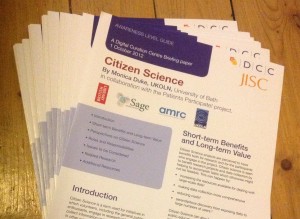This post gives a brief overview of a selection of systems that are used to support citizen science or crowd sourcing activities. The examples are selected to illustrate a range of activities and systems and provide an idea of the functionality supported. The systems are Galaxy Zoo, PatientsLikeMe, Acawiki, CoCoCo, Hyperwords and WikiMedia Medicine Portal.
Who is behind this initiative?
Galaxy Zoo started in June 2007, with Chris Lintott as principal investigator, and asked users to look at images of galaxies from the Sloan Digital Sky Survey (SDSS). The team consists of astronomers and developers in different universities in the UK and the US, with support from teams in several other countries. http://www.galaxyzoo.org/team
What is it for?
Galaxy Zoo is an initiative in which volunteers classify images of galaxies. Volunteers provide descriptions of the galaxies helping to build a database of characteristics of galaxies (e.g. shape and direction of rotation). This can lead to new discoveries, for example showing that although red galaxies were thought to be elliptical, several of them are spiral. Some new objects, such as the voorwerp, have also been found. Results have been published in peer-reviewed journals.
How does the crowd participate?
The users examine the pictures and click on buttons to select the properties of galaxies, from a selection of characteristics. Before getting started the volunteers follow a simple on-line tutorial on galaxy types and can have a go at trying to classify the galaxies. They are then tested on what they have learned to check that their classifications are reliable, and can then move on to making classifying galaxies.
Users are supported by these other features:
- a blog (www.galaxyzooblog.org) where the research team writes about the research that they are conducting, and volunteers ask questions and receive answers in the comments section.
- a forum (www.galaxyzooforum.org) where volunteers communicate with one another. The volunteers can share images of beautiful galaxies that they have seen while classifying, discuss Galaxy Zoo research projects, ask and answer questions about astronomy and coordinate meetups between volunteers in real life. Scientists also contribute to the forum.
The volunteers have also taken the initiative to identify research questions for themselves and get organised to try and answer them.
References:
Raddick, M. J., Bracey, G., Carney, K., Gyuk, G., Borne, K., Wallin, J., Jacoby, S., et al. (2009). Citizen Science: Status and Research Directions for the Coming Decade. AGB Stars and Related Phenomena Aastro2010 The Astronomy and Astrophysics Decadal Survey, 2010, 46P. http://www8.nationalacademies.org/astro2010/DetailFileDisplay.aspx?id=454
Raddick, M. J., Bracey, G., Gay, P. L., Lintott, C. J., Murray, P., Schawinski, K., Szalay, A. S., et al. (2009). Galaxy Zoo: Exploring the Motivations of Citizen Science Volunteers. Astronomy Education Review, 9(1), 15. AAS. http://arxiv.org/abs/0909.2925
Who is behind this initiative?
Patients like me was founded in 2004. The founders were motivated by the diagnosis of a friend/family member who was diagnosed with an illness. PatientsLikeMe operates as a for-profit company but claims that its mission is not ‘just for profit’. They have four core values by which to operate, and form partnerships with not for profit research and industry. There is no advertising. The business model is based around selling anonymised aggregated data and collaboration with industry and researchers to carry out market research and promote clinical trials.
What is it for?
The site has been built around the assumption that patients have a primary question “Given my current situation, what is the best outcome I can expect to achieve and how do I get there?” The site features and tools are then designed around being able to answer the different parts of that question e.g. a patient can match their “current situation” in terms of genetics, disease characteristics etc. The site claims that it is able to act as a a barometer of patient perceptions (e.g. their response to news about adverse effects of a drug) by monitoring feeling in the discussion forums, and suggests that the site is more effective at measuring the rates of side effects, which are reported at a higher % through the site compared to the percentages reported in clinical trials.
PatientsLikeMe has chosen to prioritise enabling peer-interaction over providing medical advice through the site, thus allowing the patient-patient exchanges to be the source of information derived from their own personal experience, using personal pages and forums.
How does the crowd participate?
PatientsLikeMe has 40,000 patients organised around disease communities. Patients can anonymously share their personal treatment, symptom, progression and outcome data, and participation is free. Patients can also participate in experiments, and are involved in collecting adverse effect data. Research has been carried out on the outcomes for patients who share health data. The benefits identified include finding other patients who understand the condition and treatments, and making decisions on medications.
Reference:
Brownstein, C. A., Brownstein, J. S., Williams, D. S., Wicks, P., & Heywood, J. A. (2009). The power of social networking in medicine. Nature Biotechnology, 27(10), 888-890. Nature Publishing Group. http://www.ncbi.nlm.nih.gov/pubmed/19816437
Wicks P, Massagli M, Frost J, Brownstein C, Okun S, Vaughan T, Bradley R, Heywood J.
J Med Internet Res. 2010 Jun 14;12(2):e19. http://www.ncbi.nlm.nih.gov/pubmed
Who is behind this initiative?
Neeru Paharia is acknowledged as the founder of acawiki.org, with a small group of volunteers to help drive the initiative. It is run by a Californian non-profit organisation (AcaWiki Inc) and received a start-up grant from Hewlett Packard.
What is it for?
It is a site run on a wiki platform, that invites summaries of academic articles to make them more accessible. “AcaWiki is building a community of scholars, graduate students, and bloggers to write summaries of papers that are of the most general interest to the public”. The aims of the site are to “make academic scholarship widely available” and to “make it accessible to a wide audience” and generally increase public engagement with scholarship. As of October 2011 it has over 860 summaries written in areas like economics, psychology, sociology, business and computer science.
How does the crowd participate?
Users write summaries of academic articles following the posting guidelines. The users can also contribute ideas to help the site grow – for example a project to summarise the top papers in each academic discipline was suggested by one of the community. http://acawiki.org/AcaWiki:Top_100_Papers
Reference: http://acawiki.org/AcaWiki:FAQ
Who is behind this initiative?
CoCoCo (Community Contributed Collection) software was developed for the Great War Archive project by Oxford University and was used for the Great War Archive Initiative the Woruldhord project, and the Europeana Erster Weltkrieg Project.
What is it for?
CoCoCo (Community Contributed Collection) is a Ruby on Rails Web application used to collect and catalogue content contributed by website users. That content can be either textual or consist of uploaded files with metadata collected via form fields. The quality assessment of contributions is performed by administrators by adding metadata and marking suitable items as “approved”. The software is available as open source and there is documentation available to help the various users and tasks: for contributors to make and review submissions, and for cataloguers and administrators to help set up an instance of the software, define and configure metadata and set collection parameters, and to edit interfaces and set up a site.
How does the crowd participate?
Contributors fill in a form and optionally can add images, sound files or text documents to their submissions. The participants provide content for the collections being managed through CoCoCo. The RunCoCo team have written a report offering advice on how the public has been engaged in the projects using the CoCoCo software, including using events to meet volunteers who bring materials for the collection, using Flickr groups and other social media like blogs and discussion fora to build the community. One of the collections built using the software (Woruldhord) ran only for a limited time and now offers the resources collected through a website – the collection relied on online methods of communication only.
Reference:
RunCoCo Project. (2011) Final Report: How To Run A Community Collection Online. http://projects.oucs.ox.ac.uk/runcoco/resources/RunCoCo_Report.pdf.
Who is behind this initiative?
Hyperwords is made available by the Hyperwords Company which is run by Frode Hegland, a London-based Norwegian philosopher. The company has an advisory board and development teams in Europe. http://www.hyperwords.net/about_us.html A ‘liquid information’ philosophy underlines the design ideas, and is inspired by the work of Doug Engelbart.
What is it for?
Hyperwords makes the words within text interactive. It is available as a browser plug-in (and other solutions). An icon appears next to the words, which can then be clicked to issue a command. The command can bring up a minibrowser with the results of the command. The command depends on the text to which it is associated. The examples given include a ‘reference’ command for Barack Obama which can bring up information e.g. from Wikipedia about Barack Obama. For currency values, the commands could be used for currency conversions.
How does the crowd participate?
The software can be used to help users to connect to information provided by others (e.g. explanation of medical terms) and also to share information through social media.
Who is behind this initiative?
The site is run as a wikipedia portal. As with the rest of wikipedia, portals can be edited by anyone and are the work of the community that engages with them. Some of the backgrounds for contributors to the Medicine Portal section are listed as a retired academic and a student, and include users who appear to have a medical or scientific background (among others).
What is it for?
This is a wiki-based portal to various Medicine-related topics, and includes links to articles, images, quotations and news, as well other resources, and is part of the numerous wikipedia portals to different topics. Information related to medicine is presented at this site. Various topics are addressed, including diseases, history, areas of medicine, equipment and treatment. Portals in wikipedia are intended to aid navigation by acting as main pages for topic areas. They comply with wikipedia’s policies. http://en.wikipedia.org/wiki/Wikipedia:Portal
How does the crowd participate?
The contributors to wikipedia participate by adding information, editing existing information, creating new sections and raising queries and discussion points on the information presented. There is a manual of style which suggests the correct way of writing about medicine in wikipedia, for example use of correct nomenclature for disease and drugs. http://en.wikipedia.org/wiki/Wikipedia:Manual_of_Style_(medicine-related_articles). A discussion section http://en.wikipedia.org/wiki/Portal_talk:Medicine is used for discussions around writing on medical topics in wikipedia. The lists of contributors can be viewed through links, and contributors can write their profile with information about their background.

